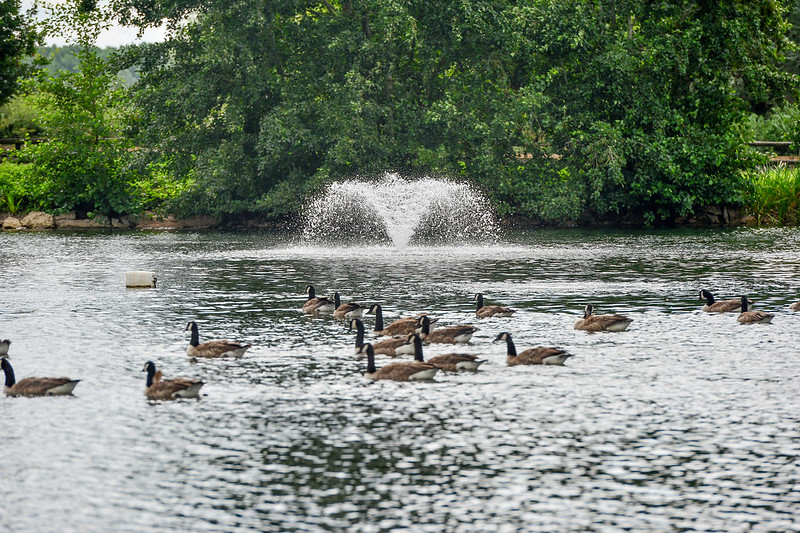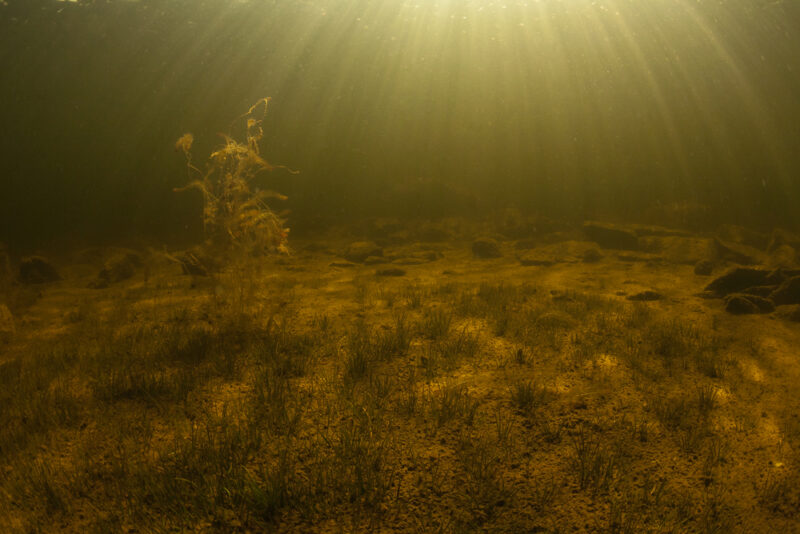Inside lake aeration and water quality
The importance of water quality and how to breathe new life into your lakes and ponds
Water is a precious, recyclable resource and managing its quality is a critical element of any successful management protocol for golf courses, sports venues, parks, and properties.
And while the presence of water is a welcome addition to any environment, without due care and attention lakes, ponds, and reservoirs can end up murky rather than magical and have a negative impact on the environment, irrigation systems, turf, and the aesthetic value of your landscape.
The importance of understanding water quality for lakes and ponds
Consider the negative impact of ingesting polluted water and air. These same principles hold true in aquatic ecosystems and in managing golf courses, landscapes, and properties.
However, people often treat visible symptoms of poor water quality, such as excessive algae blooms, aquatic vegetation growth, bad odours, and clogged sprinklers, valves, and pumps, instead of preventing them in the first place.
By increasing your understanding of the problems that lead to water quality issues, you’ll be better able to develop a balanced management and prevention programme for your water.

What environmental factors impact water quality?
As greenkeepers, course managers, or property management professionals, we’re aware of our responsibilities and our ability to make a positive impact on the environment.
Therefore, it’s important we consider factors that impact water quality. The most significant factors affecting water quality are light, temperature, nutrients, and oxygen.
1. Light
Most of the energy that controls the metabolism of a lake comes directly from solar energy utilised in photosynthesis. Photosynthesis occurs in the upper layer of water, or the euphotic zone, as this is the only area in the water column that sunlight is able to penetrate.
Shallow bodies of water, which are less than 9ft/3m in depth, more commonly experience problems such as bottom-rooted weeds or benthic algae and need additional consideration when determining the correct water management solution.
2. Temperature
Thermal stratification, or temperature layering, impacts water quality in a lake due to its effect on dissolved oxygen level. As the sun shines on the water’s surface it warms it, and because warm water is less dense, cold water becomes trapped at the pond’s bottom.
As a result, the water becomes stratified, or separated into layers, and these layers don’t mix, which encourages algae growth throughout the warm surface layers of water. As water temperature increases, its capacity to hold oxygen drops – for example, water at 52ºF/11ºC can hold over 40 percent more oxygen than water at 80ºF/27ºC.
3. Nutrients
There is also a direct correlation in the level of available nutrients and the population of algae and aquatic weeds, which makes this another important consideration for grounds teams and management professionals.
How does excess nutrients and eutrophication affect water quality?
The term eutrophication applies to the increase in the nutrient load of a water body over time. It occurs in water bodies, such as lakes, estuaries, or slow-moving streams, and can cause the growth of planktonic algae and blue-green algae.
Eutrophication depletes available oxygen and creates an unfavourable environment, which can lead to the death of aquatic animals, reduce ecological diversity, and cause bad smells.

How does excess nutrients build up in ponds and lakes?
Excess nutrients can come from many sources, such as fertilisers, through soil erosion, and sewage treatment plant discharges; phosphorus and nitrogen are key when it comes to water quality issues.
Phosphorus has been identified as the single greatest contributor to aquatic plant growth, with just one gram of phosphorus producing 100 grams of algal biomass. It’s also the most limiting element for algal growth as many blue-green algae are unable to utilise atmospheric nitrogen.
The three most common sources of nutrient introduction are bottom silt and dead vegetation in the lake, runoff water from surrounding turf areas, and sources of incoming water such as inlets.
1. Bottom silt and vegetation
Vegetation and bottom silt are primary sources of nutrients. Although they have a two-week life cycle, blue-green algae can experience cell division and double their population as often as every 20 minutes.
At the end of the cycle, plants simply die and begin to sink to the lake’s bottom, or benthic zone.
Studies at the University of Florida have found that sediment can accumulate at a rate of one to five inches (2.5-12cm) per year in mild climates and three to eight inches (6-16cm) in tropical climates.
That means, at a midpoint accumulation rate of three inches (7cm) per year, a one surface acre (4000m2) lake can lose 80,000 gallons (300m3) of water storage capacity in a single year.
2. Surface runoff
Surface runoff is typically made up of water that is not lost via evapotranspiration and does not penetrate the surface soil to infiltrate the groundwater. Several factors affect surface loss of nutrients and pesticides, including precipitation, soil moisture content prior to rainfall, the time of chemical application, and the type of fertiliser applied.
Runoff can also come from surrounding turf areas, as well as roads, farms, and outlying areas. This runoff is known as nutrient loading. Leaves, grass clippings, and other materials will also runoff into the lakes, placing additional burdens on natural clean-up processes.
3. Incoming water sources
Nutrients are added through inlet waters coming from wastewater treatment plants and leeching from septic systems. Often, inlet waters have low oxygen and excess phosphorus – a sign of this is foaming water.
Fortunately, turf professionals have developed creative nutrient management systems. Some courses have created buffer strips using plants such as reeds along waterways to trap sediment and act as natural filters; others use live bacteria and fungi to increase nutrient uptake.
Another strategy is using grass varieties with pest resistance and high stress tolerance, as well as integrated pest management, employing natural predatory insects, for instance.
Oxygen
Oxygen supports the food chain and aids decomposition. Lakes and ponds are supplied with oxygen from several sources but primarily via photosynthesis and wave and wind action.
Immediate reactions to oxygen depletion include fish deaths or lingering odours. Long-term issues are nutrient build-up, sludge accumulation, and chemical imbalances.
Oxygen depletion or stress situations occur for different reasons, but most typically happen during:
- Late at night and just before dawn
- Cloudy, still days
- Hot, humid days
- When the water’s nutrient content is high
- After a chemical application
Understanding the difference between aerobic and anaerobic bacteria – and how this affects water quality
Nature has provided a clean-up process that will metabolise or decompose excess nutrients; this is called organic digestion and involves two types of naturally occurring bacteria present in all lakes and ponds: aerobic and anaerobic.
The most effective is aerobic bacteria, which require the presence of oxygen. Highly efficient, they are roughly seven times faster in organic digestion than anaerobic bacteria.
Anaerobic bacteria, on the other hand, exists in oxygen deficient water and soil and are much slower in breaking down nutrients, allowing soluble organic nutrients to recycle into the water column.
Furthermore, noxious by-products such as methane, ammonia, and hydrogen sulphide are created by anaerobic decomposition.
How to improve water quality with professional aeration
Balance is critical to any aquatic ecosystem – and without it, water will suffer. There are several key steps you can take to prevent imbalances, and knowing the causes of them can help find the best solution for your application.
Some methods include proper pond construction, chemical applications, and the addition of oxygen through aeration systems and devices.
Natural aeration is excellent, but when this fails the next best thing is a professional aeration. Creating currents that eliminate stagnant water, aeration mixes cool water at the bottom of a lake, reservoir or pond with warm water at the surface, helping prevent and eliminate thermal stratification.
Aeration replenishes the depleted oxygen, encouraging the production and longevity of healthy aerobic bacteria, which consume excess nutrients and return water to a healthy and stable state.
Which professional aerators are best for improving water quality?
Professional Otterbine aeration systems provide many benefits, but most importantly they improve water quality, creating clean and healthy ponds and lakes. There are three types of aeration systems available:
Surface spray systems
Surface systems provide the best aeration and vertical circulation in lakes less than 15 feet deep.
Mixing surface and bottom waters, they eliminate thermal stratification, creating convection patterns that break up mats and clumps of algae and discourage mosquitos from breeding.
Horizontal aspirators
Horizontal aspirators are ideal for lakes ranging from three to 12 feet in depth which will benefit from a strong directional flow. These aspirators create artificial currents in irregular shaped ponds and lakes, breaking up algae mats in stagnant waters. They are chosen when no spray pattern is desired.
Air diffusion systems
Onshore air compressors pump air to diffuser manifolds at the bottom of the pond or lake. Most effective in waters with depths greater than 15 feet, they can also work in waters as shallow as four feet.
In general, any bottom diffuser loses roughly 50 percent of its aeration and mixing capacity for every three foot increment of depth shallower than 15 feet.
Aeration success story: Brickendon Grange Golf Club
The difference a water feature can make is invaluable. Just take Brickendon Grange Golf Club as an example. The Hertfordshire-based club came to Reesink Hydro-Scapes with an issue: stagnating water and bad odours.
We helped the club install new surface spray aerators for its two problem ponds flanking the eighth and eighteenth holes, and since then, the five-in-one system has brought clean, clear water to the ponds. More than that, it has also created two new beauty spots for golfers and visitors to enjoy.
The fractional aerating system installed at Brickendon can keep the ecosystem of any smaller area of water in perfect balance with its ability to transfer an impressive 1kg/2.2lbs of oxygen per hp/hr and a high pumping rate of 115m3/ph.
Reesink Hydro-Scapes – your partner for professional aeration
Water quality management is a science and every lake, pond and reservoir is different. With this knowledge, you should be able to identify problems earlier, consider prevention rather than cure, and provide some solutions to existing issues in order to create water features for everyone to enjoy for years to come.
At Reesink Hydro-Scapes, we have dedicated experts on good management of lakes and ponds who are happy to run through water quality symptoms and best practice with you.
If this is of interest, or if you have any other queries, then do get in touch with us at Reesink Hydro-Scapes on 01480 226948.